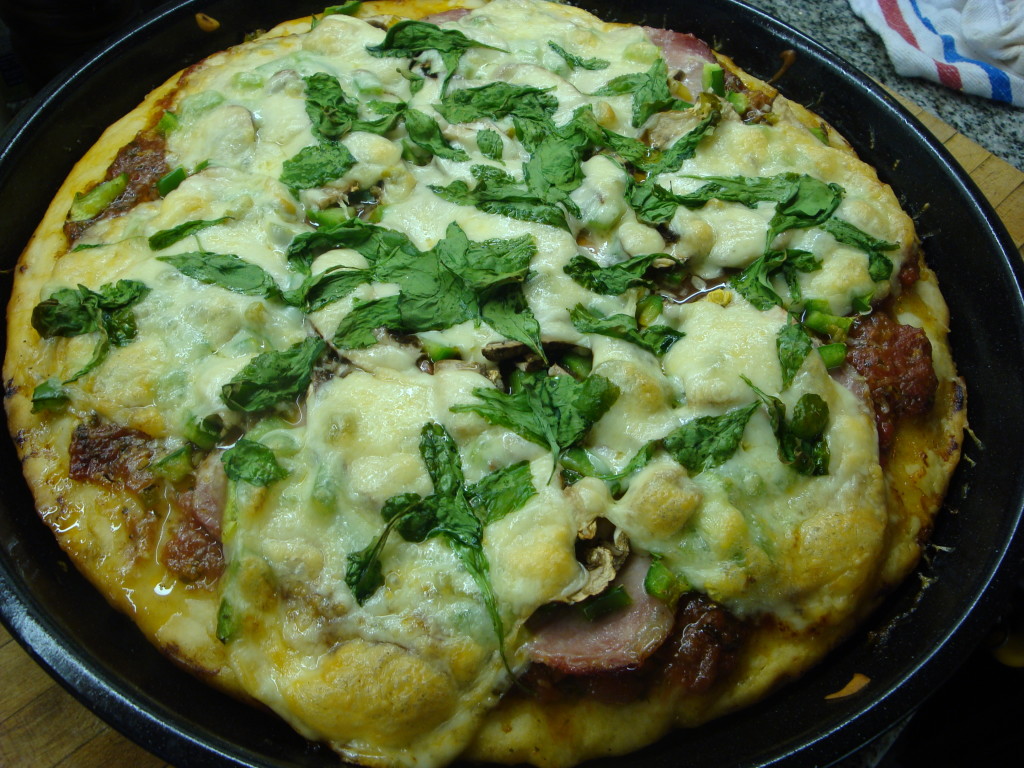Batter up for pizza!
On Sunday supplement
Food and Wine
This column started a few months back with a look at one of Argentina’s contributions to the world of pizza, the pizza a la parrilla, or grilled pizza. Now, as we all know, pizza is nature’s most perfect food, encompassing the fabled food pyramid in just the right proportions, or, when paired appropriately with pitchers of soft drinks and beers, the four basic food groups of salt, fat sugar, alcohol/caffeine. All the things we love to eat and love to hate because we know, somewhere in the dark recesses of our brains, that they’re just not good for us. It doesn’t stop us from diving in, but we know about it.
With the success of two recent columns heading into gluten-free territory, I decided to throw in one more, especially because after mentioning that I’ve come up with a good gluten-free pizza crust, I got hit with a whole bunch of e-mails asking for the recipe. Likely this will be the last GF write-up for awhile, although you never know. These things have a way of working themselves out.
Now, the first part of this is coming up with a decent gluten free flour mixture. Anyone who’s ever been subjected to most of the pre-mixes out there on the market knows that they have a tendency to come out with the color and texture of a dry-cleaner’s shirt cardboard. The flavor hovers somewhere between yuck and god-awful. And that’s surprising, because there are plenty of folk out there who’ve written blogs and books and actually come up with excellent alternatives to wheat flour when it comes to baked goods. Yet, the corporate giants of “food” production seem to think that if they makes something that tastes, looks, and feels good, no one will believe it’s good for them.
So, the crust. Tried and true by both us and numerous friends – those who weren’t on gluten free diets who we didn’t tell, didn’t spot the difference. That’s as good as you can want!
240 grams rice flour
80 grams potato starch
80 grams mandioca/tapioca starch
2½ tablespoons powdered milk
1¼ tablespoons honey
1¼ teaspoons baking powder
1 teaspoon salt
1 egg
1 packet instant yeast or ½ cube of fresh
300 ml warm water
2½ tablespoons olive oil
Combine the last three ingredients together and set aside for 30 minutes until bubbly and yeasty smelling. Beat together with dry ingredients in a mixer (doing this by hand takes a lot of work to get it really completely lump-free). Let it rise for 30 minutes, covered, it should be bubbly and have risen a bit, though not as much as traditional wheat dough.
The dough will be like a very thick batter, it’s not something you can knead like a traditional pizza dough. Oil a pizza pan well. Pour the dough in the pan and press/spread it out evenly. Let sit for 15 minutes somewhere warm. Bake in hottest possible oven for 7-8 minutes on the bottom rack, until the top is just set and it’s starting to turn golden underneath. Top with your favorite toppings and return to oven to finish baking – about another 10 minutes.
Here’s my quick and easy pizza sauce for when you don’t have time to slow cook one:
1 can whole, peeled plum tomatoes
2 cloves garlic, coarsely chopped
2 teaspoons each of dried parsley and oregano
1 teaspoon chili flakes
salt and pepper to taste
olive oil
Cook garlic in oil until turning golden. Add other ingredients and cook for 20 minutes over low heat. Feel free to adjust it spicier if you like with more chili flakes, or fresh chilies.
After the dough is just set, as described above, spread as much of this sauce as you like on top of the dough, scatter the other ingredients, and top with cheese.
A series of recipes and articles that I started writing for the Buenos Aires Herald Sunday supplement, Food & Wine section, at the beginning of 2012. My original proposal to them was to take local favorite dishes and classics and lighten them up for modern day sensibilities. We’re not talking spa or diet recipes, but at the very least, making them healthier in content, particularly salt, fat and portion size. As time went by, that morphed into a recipe column that, while emphasizing food that is relatively “good for you”, wasn’t necessarily focused on local cuisine. At the beginning of 2013 I decided to stop writing for them over some administrative issues, but it was fun while it lasted.
